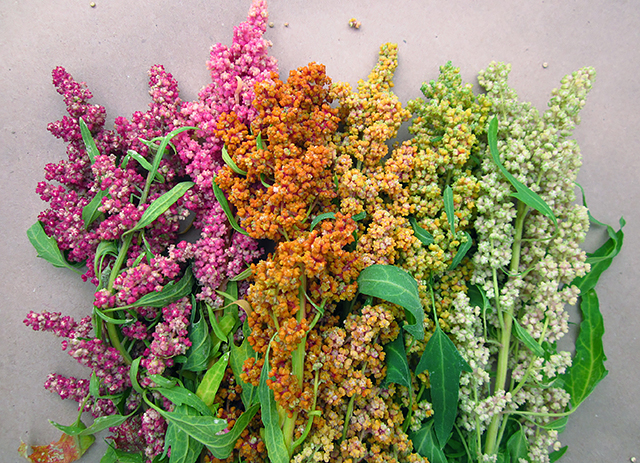USA
May 16, 2022

Scientists are evaluating beneficial bacteria to help quinoa adapt to new growing regions of the world and tackle malnutrition. (Photo by Anna Testen, ARS)
Quinoa (pronounced "KEEN-wah") is increasingly popular as a high-protein, slightly nutty flavored grain-like seed that can be made into flour for bread and pasta, used in soups and cereal, eaten as a snack food, and fermented into alcoholic beverages like beer.
Colorado and Nevada currently lead U.S production of quinoa, but Agricultural Research Service (ARS) and collaborating scientists are looking for ways to support the domestic expansion of this highly nutritious "pseudo-grain," which is native to the Andean region and has been grown as a staple food crop by indigenous people there for several thousand years.
One of the ways scientists hope to expand quinoa's U.S. production and satisfy increasing consumer demand is to help the crop better cope with new pest and disease threats that it may encounter, as well as environmental or climatic stressors, like saline soils and drought. Interestingly, one solution may come in the form of symbiotic bacteria that ask for little more than a home on the quinoa plant's roots. In return, the scientists are learning, the bacteria help their plant hosts flourish by making nutrients more available to it and by fending off disease-causing fungi, among other benefits.
Anna Testen, a research plant pathologist with ARS's Application Technology Research Unit in Wooster, Ohio, is investigating the quinoa-friendly bacteria together with Paul Blackman, professor emeritus at Pennsylvania State University in University Park, Pa., and Mayra Claros Magnus, former head of the PROINPA Foundation's Microbiology Laboratory in Cochabamba, Bolivia.
Their aim is to tease out the bacteria's potential use as a seed inoculant that could benefit the quinoa crop from the moment it germinates in soil to the time it reaches full maturity and is ready for harvest. More broadly, their research dovetails with efforts around the world to position quinoa as a protein-, vitamin- and fiber-rich pseudo-grain crop that can contribute to world food security, especially in resource-limited regions. Indeed, the United Nations declared 2013 the "International Year of Quinoa" in recognition of the crop's adaptability, nutritional value and potential to help tackle chronic malnutrition.
In studies, the team evaluated growth-promoting traits in nearly 500 different specimens, or "isolates," of symbiotic Bacillus bacteria collected from the roots, shoots or leaves of quinoa plants in Bolivia and Ecuador as well as from lambsquarters (a weedy species of Chenopodium and annual relative of quinoa) in Pennsylvania.
Specifically, the team evaluated the isolates for five traits: the ability to solubilize phosphorus (render it useable by the quinoa plant) and produce phytase (which plays a key role in making that nutrient available), indole acetic acid (a key plant hormone known as "IAA") and chitinase (which degrades chitin in fungal cell walls). The fifth trait was the ability to prevent the growth of Fusarium oxysporum fungi that cause "damping off" disease and root rots in quinoa.
Test results, reported in an upcoming issue of Plant Health Progress, showed that 75 percent of the Bacillus isolates solubilized phosphorus, while 89, 44 and 13 percent produced phytase, IAA and chitinase, respectively. Only about eight percent stymied the Fusarium fungi in petri dish experiments.
Testen said Bacillus species that offer all five growth-promoting traits would be ideal candidates for use in seed inoculant products that farmers can use—but especially if the bacteria are indigenous to an area where a quinoa crop will be introduced and grown. The use of molecular markers—analogous to road signs on an organism's genomic "superhighway"—could help researchers identify such species and target a specific trait they offer, like high phosphorus solubilization, to a specific quinoa production need.
"Phytosanitary rules may prohibit beneficial microbes from being transported and introduced along with quinoa when the plant is introduced to a new region," Testen said. "Because of this, there may be interest in finding local microbes that are adapted to Chenopodium species and local environmental conditions. The best bet for this is to look to native Chenopodium weeds like lambsquarters that are closely related to quinoa."
Testen plans additional research on Bacillus in specialty crop production systems, including hydroponic vegetable systems, as well as cost-effective ways of producing the beneficial bacteria for use in inoculant products.
The Agricultural Research Service is the U.S. Department of Agriculture's chief scientific in-house research agency. Daily, ARS focuses on solutions to agricultural problems affecting America. Each dollar invested in agricultural research results in $17 of economic impact.